A Business Development Plan for AirAsia Berhad: A Case Study Analysis
VerifiedAdded on 2023/01/06
|44
|15084
|3
Thesis and Dissertation
AI Summary
This thesis presents a comprehensive business development plan for AirAsia Berhad, a Malaysian low-cost airline. The study begins with an introduction to the industry and company background, highlighting the business issue of increasing competition and the impact of the COVID-19 pandemic. It outlines the purpose and rationale for the research, including research questions and objectives. The business review section covers the increasing use of data science, the complex distribution landscape, and airport protection. The research design details the research and collection methods, along with ethical considerations. Data analysis includes CASE analysis, exploring the COVID-19 impact, structuring in the airline, hybrid concepts, and mergers and acquisitions. The study then discusses the business implications. The conclusion and recommendations provide vision, mission, objectives, functional plans, implementation schedule, critical success factors, and risk mitigation strategies, supported by SWOT, PESTLE, and McKinsey 7S analyses. The thesis aims to enhance AirAsia's business performance through strategic development.
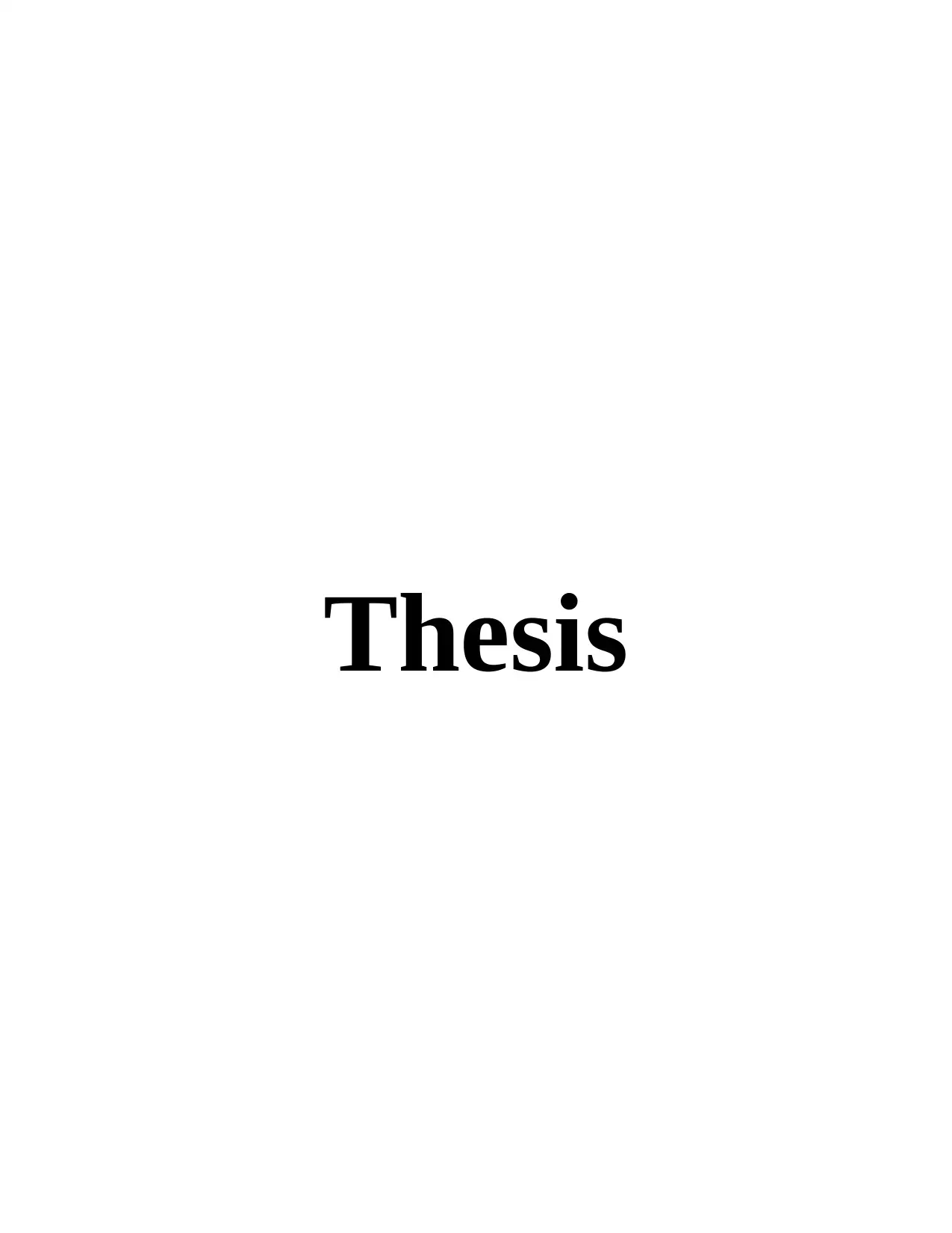
Thesis
Paraphrase This Document
Need a fresh take? Get an instant paraphrase of this document with our AI Paraphraser
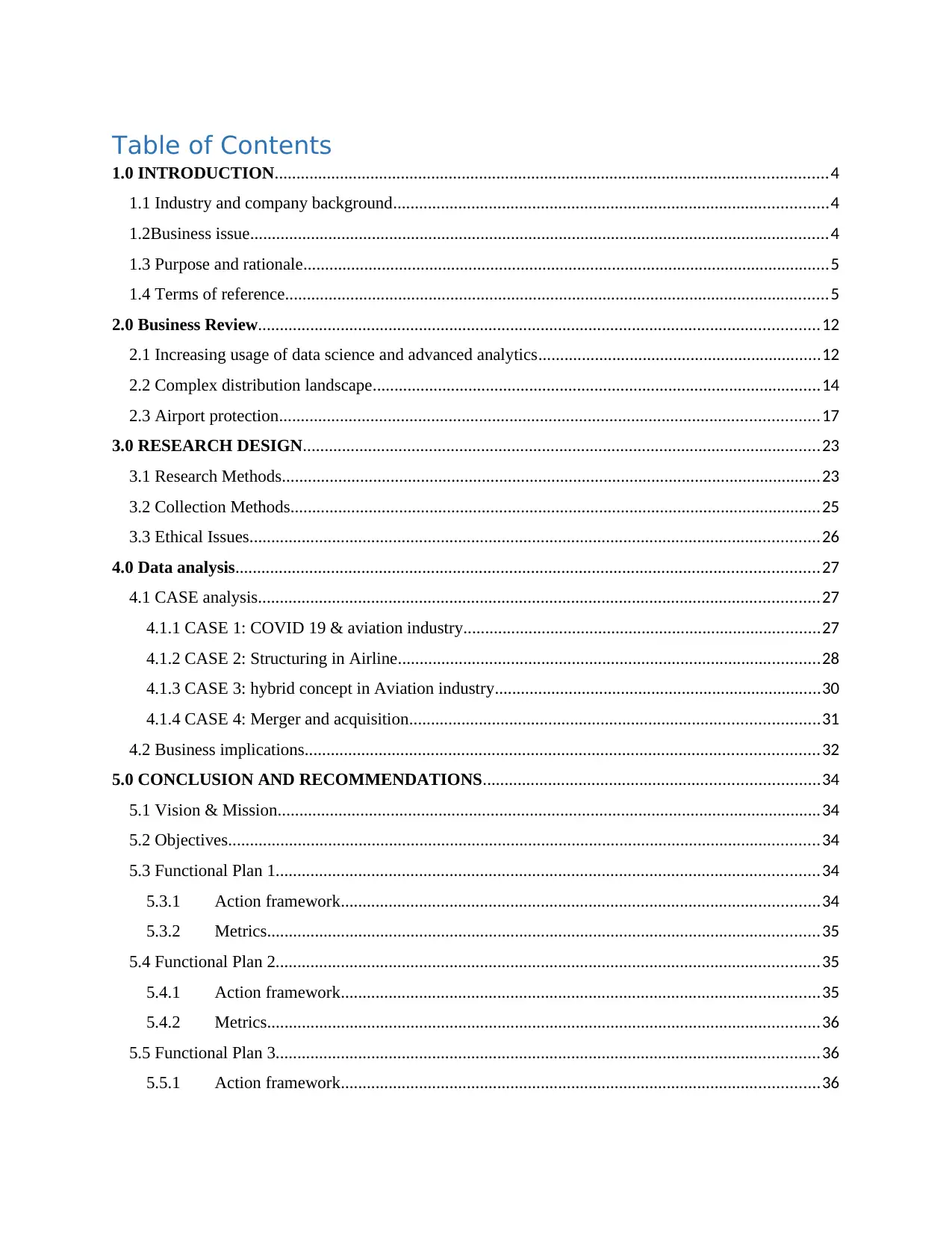
Table of Contents
1.0 INTRODUCTION...............................................................................................................................4
1.1 Industry and company background....................................................................................................4
1.2Business issue.....................................................................................................................................4
1.3 Purpose and rationale.........................................................................................................................5
1.4 Terms of reference.............................................................................................................................5
2.0 Business Review.................................................................................................................................12
2.1 Increasing usage of data science and advanced analytics.................................................................12
2.2 Complex distribution landscape.......................................................................................................14
2.3 Airport protection............................................................................................................................17
3.0 RESEARCH DESIGN.......................................................................................................................23
3.1 Research Methods............................................................................................................................23
3.2 Collection Methods..........................................................................................................................25
3.3 Ethical Issues...................................................................................................................................26
4.0 Data analysis......................................................................................................................................27
4.1 CASE analysis.................................................................................................................................27
4.1.1 CASE 1: COVID 19 & aviation industry..................................................................................27
4.1.2 CASE 2: Structuring in Airline.................................................................................................28
4.1.3 CASE 3: hybrid concept in Aviation industry...........................................................................30
4.1.4 CASE 4: Merger and acquisition..............................................................................................31
4.2 Business implications......................................................................................................................32
5.0 CONCLUSION AND RECOMMENDATIONS.............................................................................34
5.1 Vision & Mission.............................................................................................................................34
5.2 Objectives........................................................................................................................................34
5.3 Functional Plan 1.............................................................................................................................34
5.3.1 Action framework..............................................................................................................34
5.3.2 Metrics...............................................................................................................................35
5.4 Functional Plan 2.............................................................................................................................35
5.4.1 Action framework..............................................................................................................35
5.4.2 Metrics...............................................................................................................................36
5.5 Functional Plan 3.............................................................................................................................36
5.5.1 Action framework..............................................................................................................36
1.0 INTRODUCTION...............................................................................................................................4
1.1 Industry and company background....................................................................................................4
1.2Business issue.....................................................................................................................................4
1.3 Purpose and rationale.........................................................................................................................5
1.4 Terms of reference.............................................................................................................................5
2.0 Business Review.................................................................................................................................12
2.1 Increasing usage of data science and advanced analytics.................................................................12
2.2 Complex distribution landscape.......................................................................................................14
2.3 Airport protection............................................................................................................................17
3.0 RESEARCH DESIGN.......................................................................................................................23
3.1 Research Methods............................................................................................................................23
3.2 Collection Methods..........................................................................................................................25
3.3 Ethical Issues...................................................................................................................................26
4.0 Data analysis......................................................................................................................................27
4.1 CASE analysis.................................................................................................................................27
4.1.1 CASE 1: COVID 19 & aviation industry..................................................................................27
4.1.2 CASE 2: Structuring in Airline.................................................................................................28
4.1.3 CASE 3: hybrid concept in Aviation industry...........................................................................30
4.1.4 CASE 4: Merger and acquisition..............................................................................................31
4.2 Business implications......................................................................................................................32
5.0 CONCLUSION AND RECOMMENDATIONS.............................................................................34
5.1 Vision & Mission.............................................................................................................................34
5.2 Objectives........................................................................................................................................34
5.3 Functional Plan 1.............................................................................................................................34
5.3.1 Action framework..............................................................................................................34
5.3.2 Metrics...............................................................................................................................35
5.4 Functional Plan 2.............................................................................................................................35
5.4.1 Action framework..............................................................................................................35
5.4.2 Metrics...............................................................................................................................36
5.5 Functional Plan 3.............................................................................................................................36
5.5.1 Action framework..............................................................................................................36
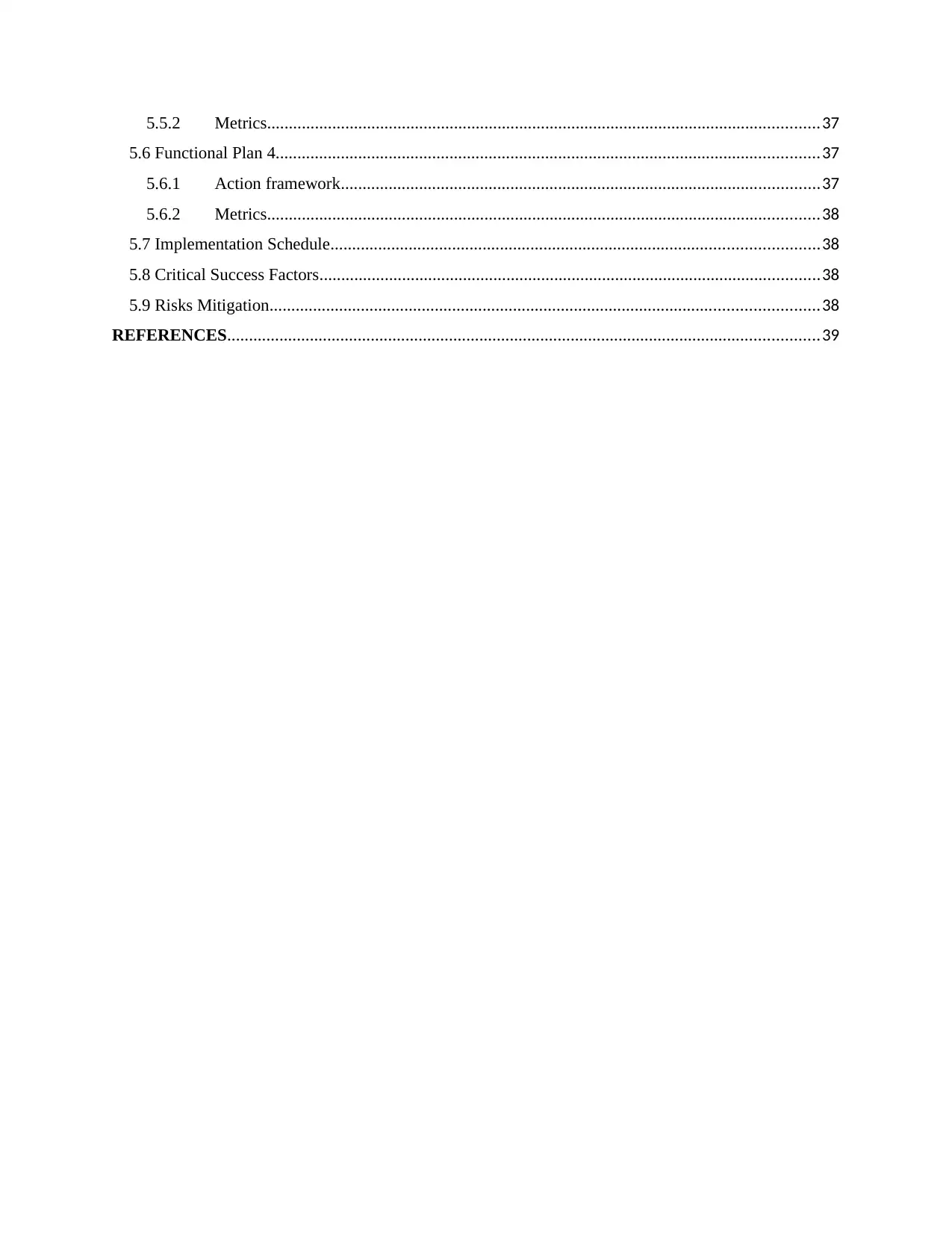
5.5.2 Metrics...............................................................................................................................37
5.6 Functional Plan 4.............................................................................................................................37
5.6.1 Action framework..............................................................................................................37
5.6.2 Metrics...............................................................................................................................38
5.7 Implementation Schedule................................................................................................................38
5.8 Critical Success Factors...................................................................................................................38
5.9 Risks Mitigation..............................................................................................................................38
REFERENCES........................................................................................................................................39
5.6 Functional Plan 4.............................................................................................................................37
5.6.1 Action framework..............................................................................................................37
5.6.2 Metrics...............................................................................................................................38
5.7 Implementation Schedule................................................................................................................38
5.8 Critical Success Factors...................................................................................................................38
5.9 Risks Mitigation..............................................................................................................................38
REFERENCES........................................................................................................................................39
⊘ This is a preview!⊘
Do you want full access?
Subscribe today to unlock all pages.

Trusted by 1+ million students worldwide
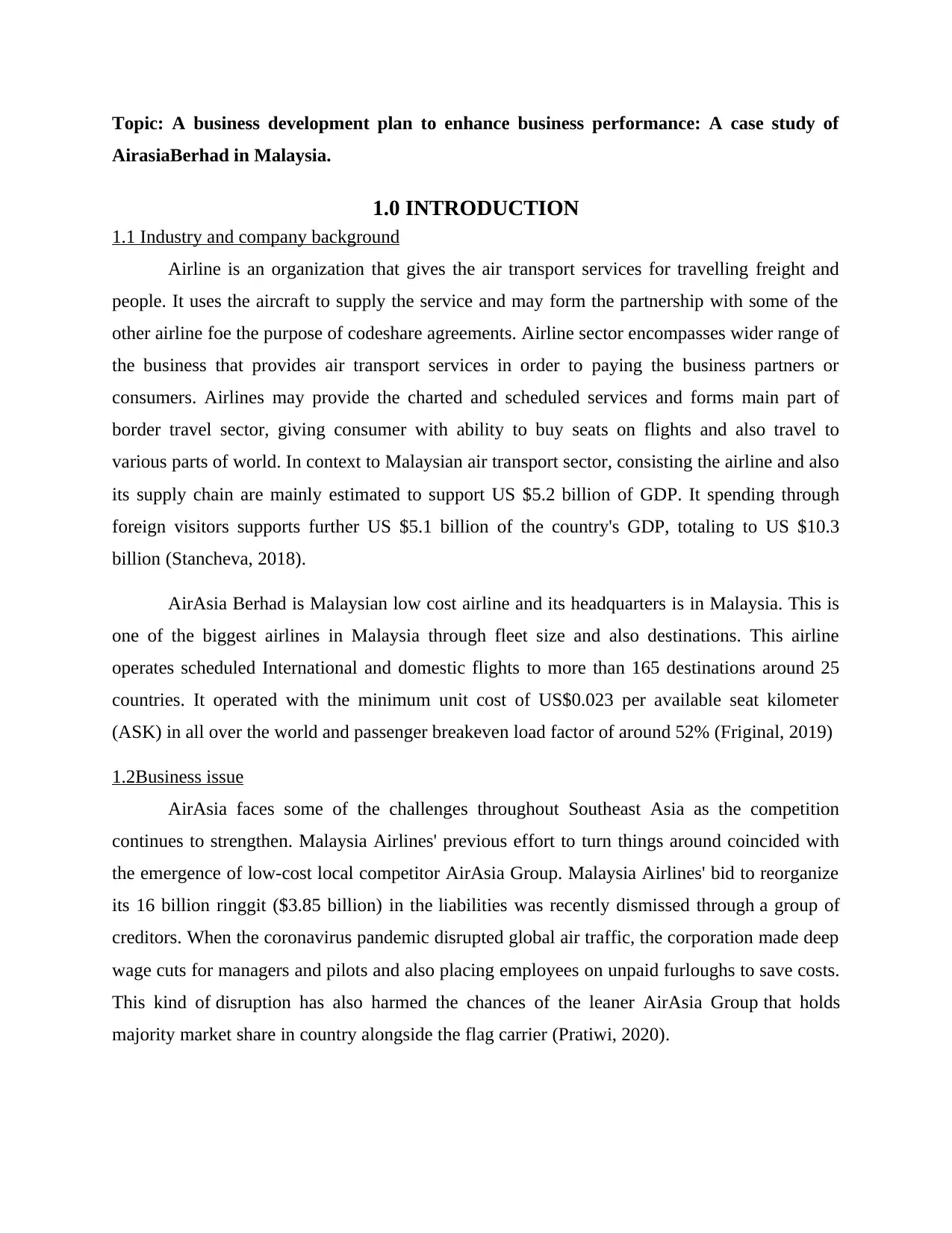
Topic: A business development plan to enhance business performance: A case study of
AirasiaBerhad in Malaysia.
1.0 INTRODUCTION
1.1 Industry and company background
Airline is an organization that gives the air transport services for travelling freight and
people. It uses the aircraft to supply the service and may form the partnership with some of the
other airline foe the purpose of codeshare agreements. Airline sector encompasses wider range of
the business that provides air transport services in order to paying the business partners or
consumers. Airlines may provide the charted and scheduled services and forms main part of
border travel sector, giving consumer with ability to buy seats on flights and also travel to
various parts of world. In context to Malaysian air transport sector, consisting the airline and also
its supply chain are mainly estimated to support US $5.2 billion of GDP. It spending through
foreign visitors supports further US $5.1 billion of the country's GDP, totaling to US $10.3
billion (Stancheva, 2018).
AirAsia Berhad is Malaysian low cost airline and its headquarters is in Malaysia. This is
one of the biggest airlines in Malaysia through fleet size and also destinations. This airline
operates scheduled International and domestic flights to more than 165 destinations around 25
countries. It operated with the minimum unit cost of US$0.023 per available seat kilometer
(ASK) in all over the world and passenger breakeven load factor of around 52% (Friginal, 2019)
1.2Business issue
AirAsia faces some of the challenges throughout Southeast Asia as the competition
continues to strengthen. Malaysia Airlines' previous effort to turn things around coincided with
the emergence of low-cost local competitor AirAsia Group. Malaysia Airlines' bid to reorganize
its 16 billion ringgit ($3.85 billion) in the liabilities was recently dismissed through a group of
creditors. When the coronavirus pandemic disrupted global air traffic, the corporation made deep
wage cuts for managers and pilots and also placing employees on unpaid furloughs to save costs.
This kind of disruption has also harmed the chances of the leaner AirAsia Group that holds
majority market share in country alongside the flag carrier (Pratiwi, 2020).
AirasiaBerhad in Malaysia.
1.0 INTRODUCTION
1.1 Industry and company background
Airline is an organization that gives the air transport services for travelling freight and
people. It uses the aircraft to supply the service and may form the partnership with some of the
other airline foe the purpose of codeshare agreements. Airline sector encompasses wider range of
the business that provides air transport services in order to paying the business partners or
consumers. Airlines may provide the charted and scheduled services and forms main part of
border travel sector, giving consumer with ability to buy seats on flights and also travel to
various parts of world. In context to Malaysian air transport sector, consisting the airline and also
its supply chain are mainly estimated to support US $5.2 billion of GDP. It spending through
foreign visitors supports further US $5.1 billion of the country's GDP, totaling to US $10.3
billion (Stancheva, 2018).
AirAsia Berhad is Malaysian low cost airline and its headquarters is in Malaysia. This is
one of the biggest airlines in Malaysia through fleet size and also destinations. This airline
operates scheduled International and domestic flights to more than 165 destinations around 25
countries. It operated with the minimum unit cost of US$0.023 per available seat kilometer
(ASK) in all over the world and passenger breakeven load factor of around 52% (Friginal, 2019)
1.2Business issue
AirAsia faces some of the challenges throughout Southeast Asia as the competition
continues to strengthen. Malaysia Airlines' previous effort to turn things around coincided with
the emergence of low-cost local competitor AirAsia Group. Malaysia Airlines' bid to reorganize
its 16 billion ringgit ($3.85 billion) in the liabilities was recently dismissed through a group of
creditors. When the coronavirus pandemic disrupted global air traffic, the corporation made deep
wage cuts for managers and pilots and also placing employees on unpaid furloughs to save costs.
This kind of disruption has also harmed the chances of the leaner AirAsia Group that holds
majority market share in country alongside the flag carrier (Pratiwi, 2020).
Paraphrase This Document
Need a fresh take? Get an instant paraphrase of this document with our AI Paraphraser
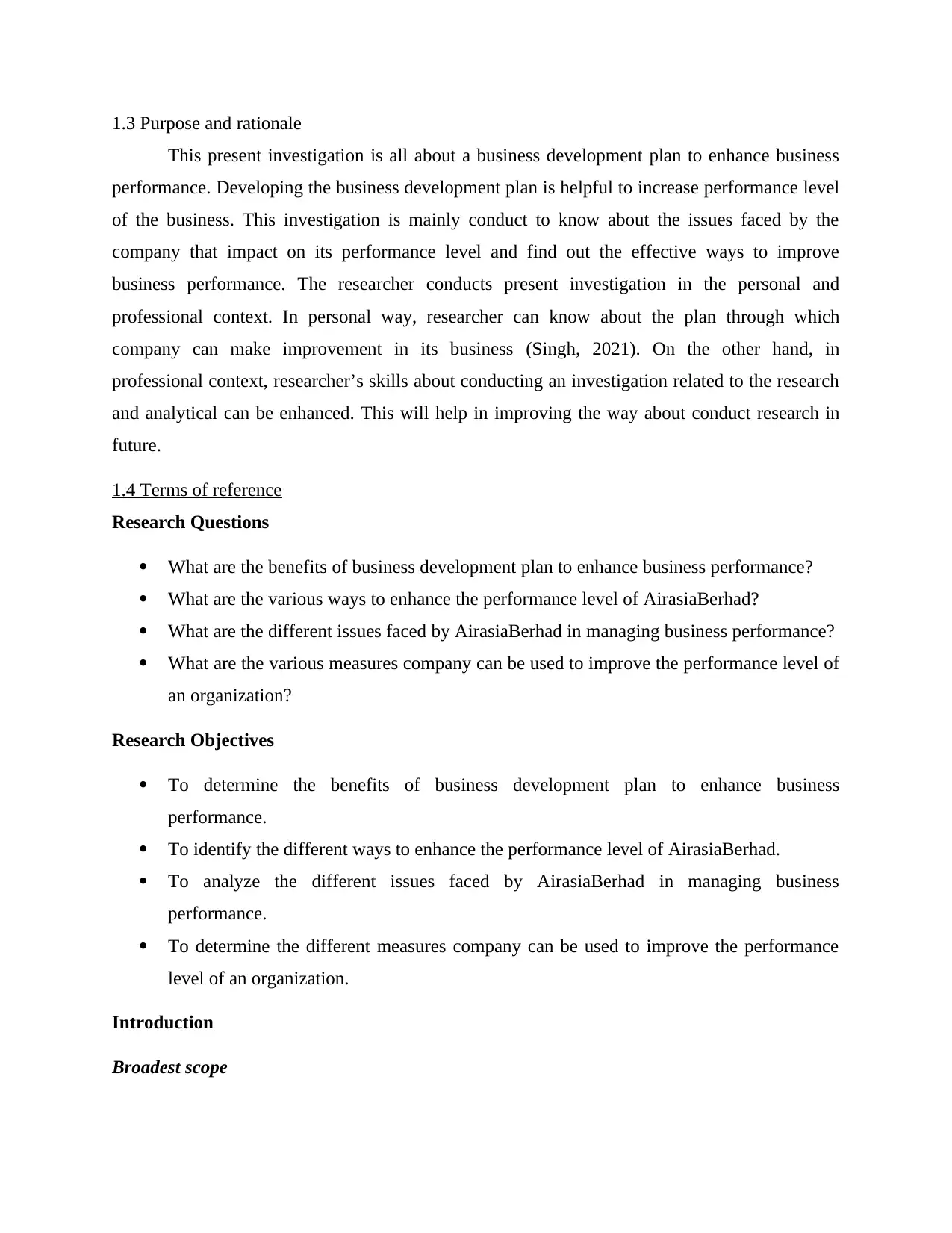
1.3 Purpose and rationale
This present investigation is all about a business development plan to enhance business
performance. Developing the business development plan is helpful to increase performance level
of the business. This investigation is mainly conduct to know about the issues faced by the
company that impact on its performance level and find out the effective ways to improve
business performance. The researcher conducts present investigation in the personal and
professional context. In personal way, researcher can know about the plan through which
company can make improvement in its business (Singh, 2021). On the other hand, in
professional context, researcher’s skills about conducting an investigation related to the research
and analytical can be enhanced. This will help in improving the way about conduct research in
future.
1.4 Terms of reference
Research Questions
What are the benefits of business development plan to enhance business performance?
What are the various ways to enhance the performance level of AirasiaBerhad?
What are the different issues faced by AirasiaBerhad in managing business performance?
What are the various measures company can be used to improve the performance level of
an organization?
Research Objectives
To determine the benefits of business development plan to enhance business
performance.
To identify the different ways to enhance the performance level of AirasiaBerhad.
To analyze the different issues faced by AirasiaBerhad in managing business
performance.
To determine the different measures company can be used to improve the performance
level of an organization.
Introduction
Broadest scope
This present investigation is all about a business development plan to enhance business
performance. Developing the business development plan is helpful to increase performance level
of the business. This investigation is mainly conduct to know about the issues faced by the
company that impact on its performance level and find out the effective ways to improve
business performance. The researcher conducts present investigation in the personal and
professional context. In personal way, researcher can know about the plan through which
company can make improvement in its business (Singh, 2021). On the other hand, in
professional context, researcher’s skills about conducting an investigation related to the research
and analytical can be enhanced. This will help in improving the way about conduct research in
future.
1.4 Terms of reference
Research Questions
What are the benefits of business development plan to enhance business performance?
What are the various ways to enhance the performance level of AirasiaBerhad?
What are the different issues faced by AirasiaBerhad in managing business performance?
What are the various measures company can be used to improve the performance level of
an organization?
Research Objectives
To determine the benefits of business development plan to enhance business
performance.
To identify the different ways to enhance the performance level of AirasiaBerhad.
To analyze the different issues faced by AirasiaBerhad in managing business
performance.
To determine the different measures company can be used to improve the performance
level of an organization.
Introduction
Broadest scope
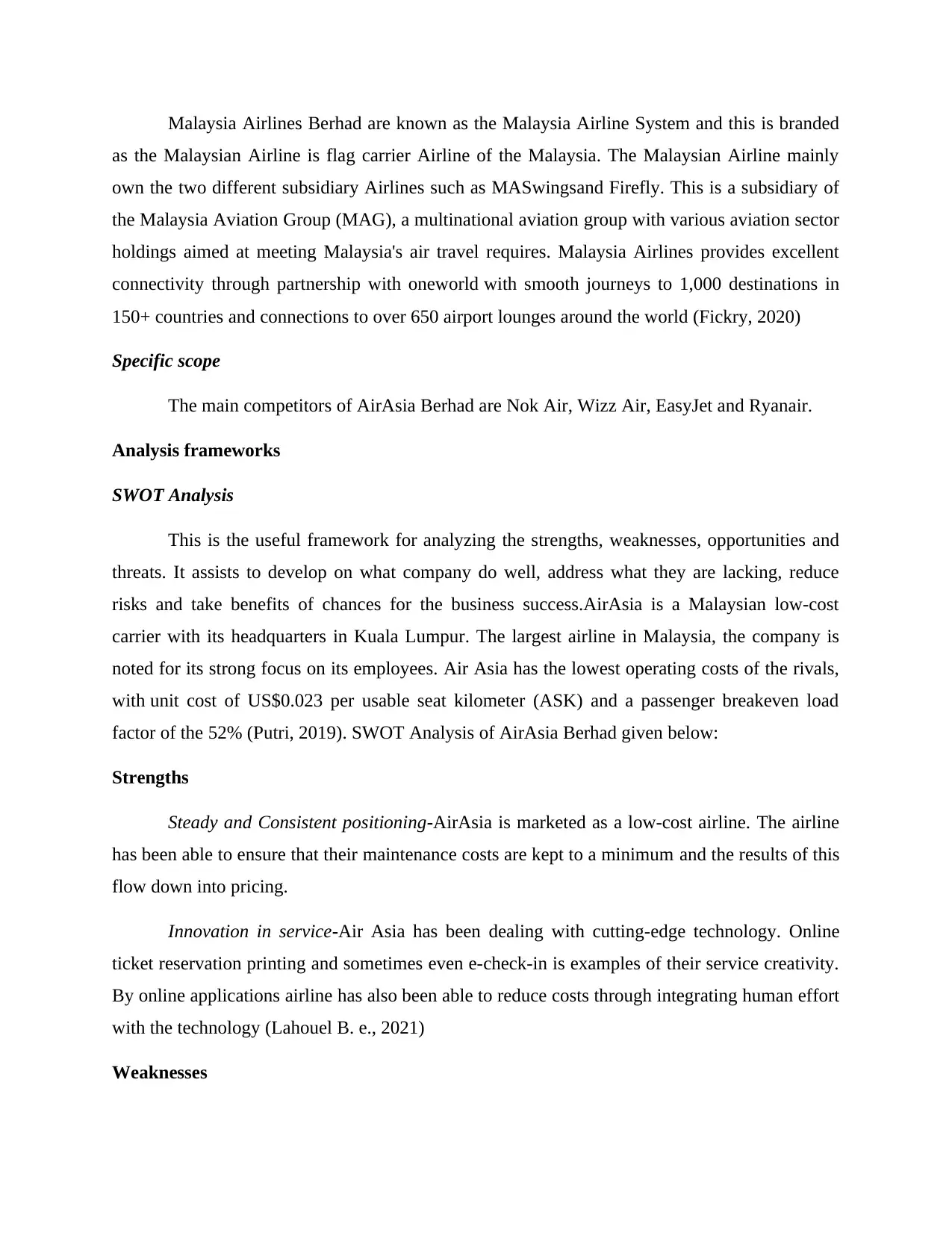
Malaysia Airlines Berhad are known as the Malaysia Airline System and this is branded
as the Malaysian Airline is flag carrier Airline of the Malaysia. The Malaysian Airline mainly
own the two different subsidiary Airlines such as MASwingsand Firefly. This is a subsidiary of
the Malaysia Aviation Group (MAG), a multinational aviation group with various aviation sector
holdings aimed at meeting Malaysia's air travel requires. Malaysia Airlines provides excellent
connectivity through partnership with oneworld with smooth journeys to 1,000 destinations in
150+ countries and connections to over 650 airport lounges around the world (Fickry, 2020)
Specific scope
The main competitors of AirAsia Berhad are Nok Air, Wizz Air, EasyJet and Ryanair.
Analysis frameworks
SWOT Analysis
This is the useful framework for analyzing the strengths, weaknesses, opportunities and
threats. It assists to develop on what company do well, address what they are lacking, reduce
risks and take benefits of chances for the business success.AirAsia is a Malaysian low-cost
carrier with its headquarters in Kuala Lumpur. The largest airline in Malaysia, the company is
noted for its strong focus on its employees. Air Asia has the lowest operating costs of the rivals,
with unit cost of US$0.023 per usable seat kilometer (ASK) and a passenger breakeven load
factor of the 52% (Putri, 2019). SWOT Analysis of AirAsia Berhad given below:
Strengths
Steady and Consistent positioning-AirAsia is marketed as a low-cost airline. The airline
has been able to ensure that their maintenance costs are kept to a minimum and the results of this
flow down into pricing.
Innovation in service-Air Asia has been dealing with cutting-edge technology. Online
ticket reservation printing and sometimes even e-check-in is examples of their service creativity.
By online applications airline has also been able to reduce costs through integrating human effort
with the technology (Lahouel B. e., 2021)
Weaknesses
as the Malaysian Airline is flag carrier Airline of the Malaysia. The Malaysian Airline mainly
own the two different subsidiary Airlines such as MASwingsand Firefly. This is a subsidiary of
the Malaysia Aviation Group (MAG), a multinational aviation group with various aviation sector
holdings aimed at meeting Malaysia's air travel requires. Malaysia Airlines provides excellent
connectivity through partnership with oneworld with smooth journeys to 1,000 destinations in
150+ countries and connections to over 650 airport lounges around the world (Fickry, 2020)
Specific scope
The main competitors of AirAsia Berhad are Nok Air, Wizz Air, EasyJet and Ryanair.
Analysis frameworks
SWOT Analysis
This is the useful framework for analyzing the strengths, weaknesses, opportunities and
threats. It assists to develop on what company do well, address what they are lacking, reduce
risks and take benefits of chances for the business success.AirAsia is a Malaysian low-cost
carrier with its headquarters in Kuala Lumpur. The largest airline in Malaysia, the company is
noted for its strong focus on its employees. Air Asia has the lowest operating costs of the rivals,
with unit cost of US$0.023 per usable seat kilometer (ASK) and a passenger breakeven load
factor of the 52% (Putri, 2019). SWOT Analysis of AirAsia Berhad given below:
Strengths
Steady and Consistent positioning-AirAsia is marketed as a low-cost airline. The airline
has been able to ensure that their maintenance costs are kept to a minimum and the results of this
flow down into pricing.
Innovation in service-Air Asia has been dealing with cutting-edge technology. Online
ticket reservation printing and sometimes even e-check-in is examples of their service creativity.
By online applications airline has also been able to reduce costs through integrating human effort
with the technology (Lahouel B. e., 2021)
Weaknesses
⊘ This is a preview!⊘
Do you want full access?
Subscribe today to unlock all pages.

Trusted by 1+ million students worldwide
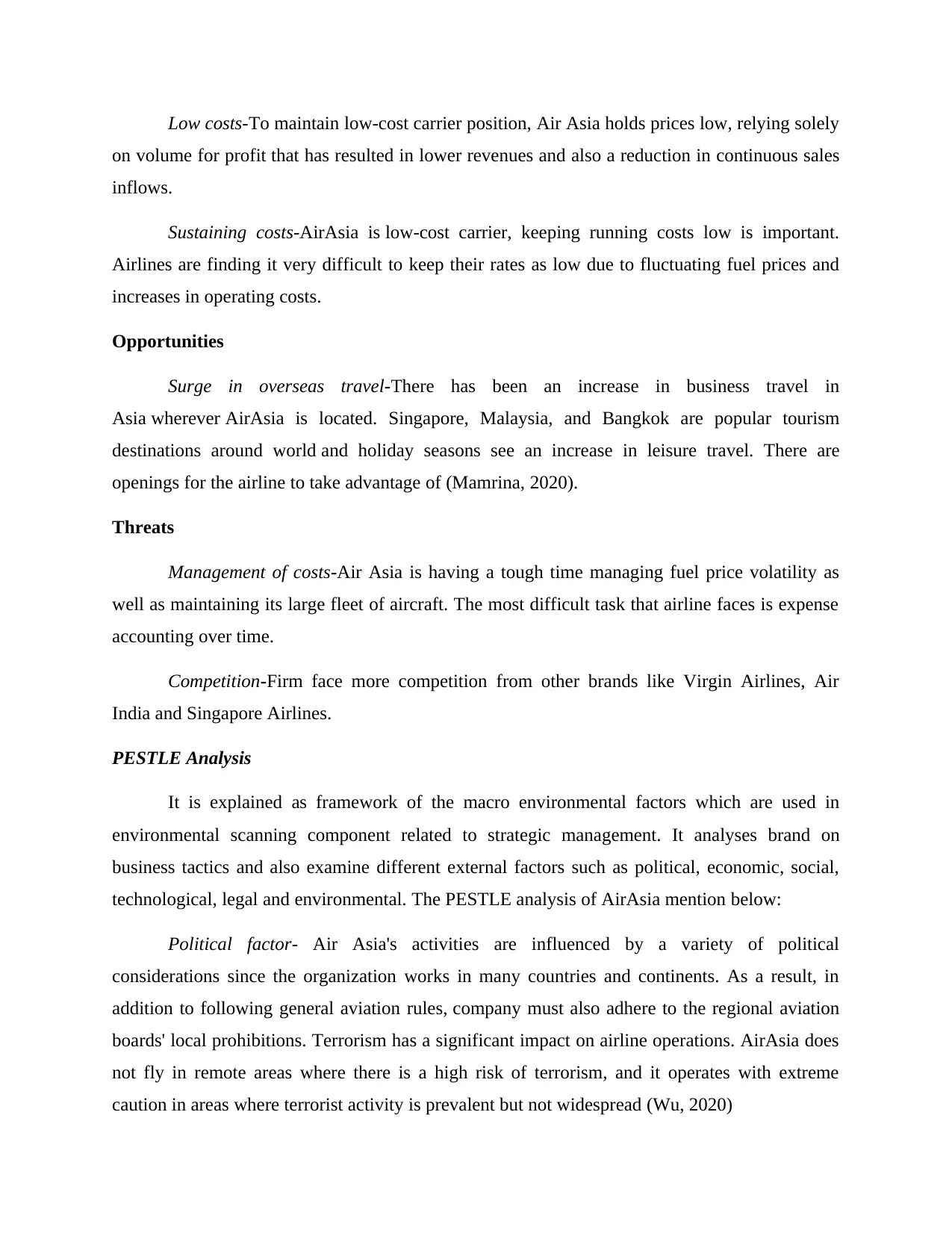
Low costs-To maintain low-cost carrier position, Air Asia holds prices low, relying solely
on volume for profit that has resulted in lower revenues and also a reduction in continuous sales
inflows.
Sustaining costs-AirAsia is low-cost carrier, keeping running costs low is important.
Airlines are finding it very difficult to keep their rates as low due to fluctuating fuel prices and
increases in operating costs.
Opportunities
Surge in overseas travel-There has been an increase in business travel in
Asia wherever AirAsia is located. Singapore, Malaysia, and Bangkok are popular tourism
destinations around world and holiday seasons see an increase in leisure travel. There are
openings for the airline to take advantage of (Mamrina, 2020).
Threats
Management of costs-Air Asia is having a tough time managing fuel price volatility as
well as maintaining its large fleet of aircraft. The most difficult task that airline faces is expense
accounting over time.
Competition-Firm face more competition from other brands like Virgin Airlines, Air
India and Singapore Airlines.
PESTLE Analysis
It is explained as framework of the macro environmental factors which are used in
environmental scanning component related to strategic management. It analyses brand on
business tactics and also examine different external factors such as political, economic, social,
technological, legal and environmental. The PESTLE analysis of AirAsia mention below:
Political factor- Air Asia's activities are influenced by a variety of political
considerations since the organization works in many countries and continents. As a result, in
addition to following general aviation rules, company must also adhere to the regional aviation
boards' local prohibitions. Terrorism has a significant impact on airline operations. AirAsia does
not fly in remote areas where there is a high risk of terrorism, and it operates with extreme
caution in areas where terrorist activity is prevalent but not widespread (Wu, 2020)
on volume for profit that has resulted in lower revenues and also a reduction in continuous sales
inflows.
Sustaining costs-AirAsia is low-cost carrier, keeping running costs low is important.
Airlines are finding it very difficult to keep their rates as low due to fluctuating fuel prices and
increases in operating costs.
Opportunities
Surge in overseas travel-There has been an increase in business travel in
Asia wherever AirAsia is located. Singapore, Malaysia, and Bangkok are popular tourism
destinations around world and holiday seasons see an increase in leisure travel. There are
openings for the airline to take advantage of (Mamrina, 2020).
Threats
Management of costs-Air Asia is having a tough time managing fuel price volatility as
well as maintaining its large fleet of aircraft. The most difficult task that airline faces is expense
accounting over time.
Competition-Firm face more competition from other brands like Virgin Airlines, Air
India and Singapore Airlines.
PESTLE Analysis
It is explained as framework of the macro environmental factors which are used in
environmental scanning component related to strategic management. It analyses brand on
business tactics and also examine different external factors such as political, economic, social,
technological, legal and environmental. The PESTLE analysis of AirAsia mention below:
Political factor- Air Asia's activities are influenced by a variety of political
considerations since the organization works in many countries and continents. As a result, in
addition to following general aviation rules, company must also adhere to the regional aviation
boards' local prohibitions. Terrorism has a significant impact on airline operations. AirAsia does
not fly in remote areas where there is a high risk of terrorism, and it operates with extreme
caution in areas where terrorist activity is prevalent but not widespread (Wu, 2020)
Paraphrase This Document
Need a fresh take? Get an instant paraphrase of this document with our AI Paraphraser
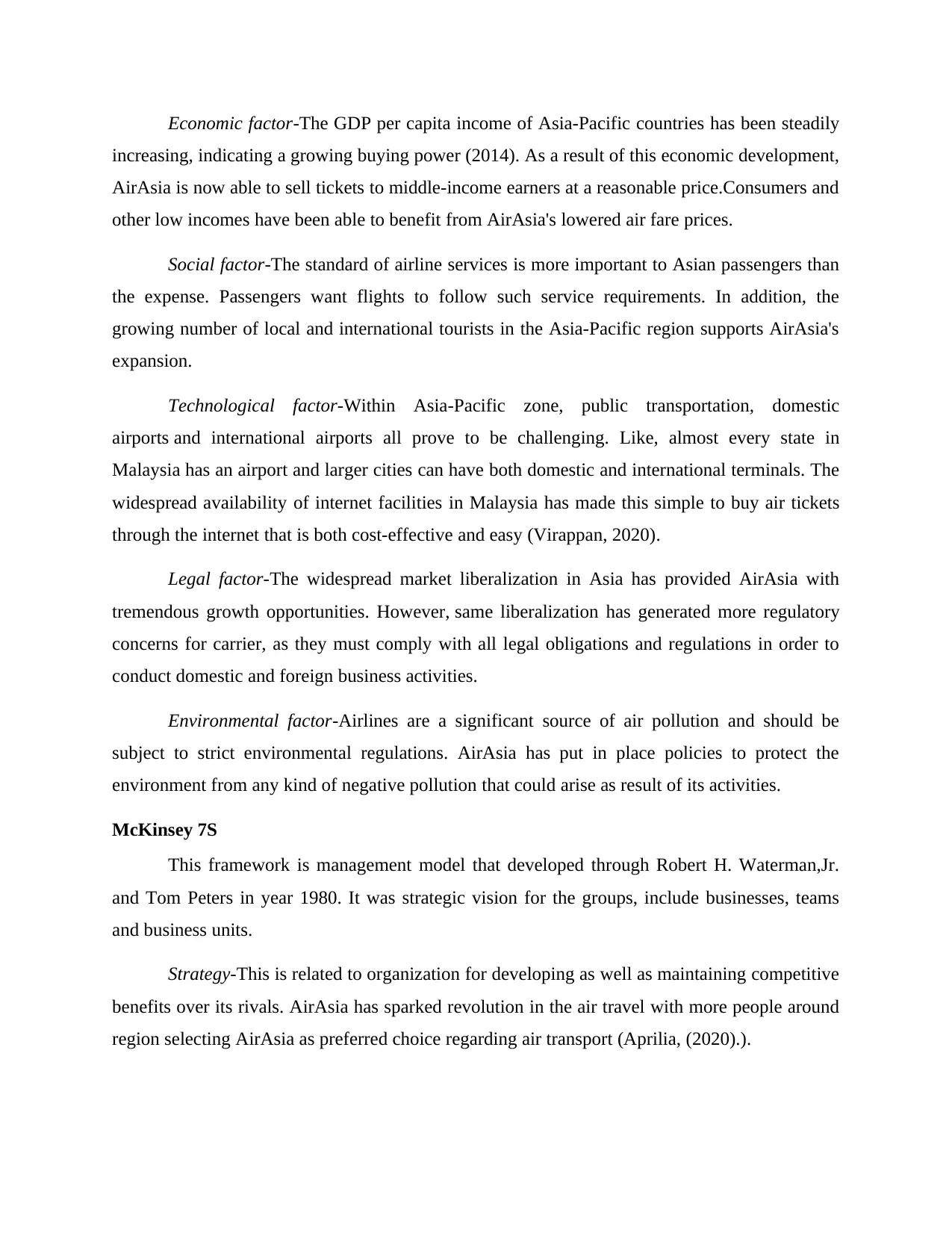
Economic factor-The GDP per capita income of Asia-Pacific countries has been steadily
increasing, indicating a growing buying power (2014). As a result of this economic development,
AirAsia is now able to sell tickets to middle-income earners at a reasonable price.Consumers and
other low incomes have been able to benefit from AirAsia's lowered air fare prices.
Social factor-The standard of airline services is more important to Asian passengers than
the expense. Passengers want flights to follow such service requirements. In addition, the
growing number of local and international tourists in the Asia-Pacific region supports AirAsia's
expansion.
Technological factor-Within Asia-Pacific zone, public transportation, domestic
airports and international airports all prove to be challenging. Like, almost every state in
Malaysia has an airport and larger cities can have both domestic and international terminals. The
widespread availability of internet facilities in Malaysia has made this simple to buy air tickets
through the internet that is both cost-effective and easy (Virappan, 2020).
Legal factor-The widespread market liberalization in Asia has provided AirAsia with
tremendous growth opportunities. However, same liberalization has generated more regulatory
concerns for carrier, as they must comply with all legal obligations and regulations in order to
conduct domestic and foreign business activities.
Environmental factor-Airlines are a significant source of air pollution and should be
subject to strict environmental regulations. AirAsia has put in place policies to protect the
environment from any kind of negative pollution that could arise as result of its activities.
McKinsey 7S
This framework is management model that developed through Robert H. Waterman,Jr.
and Tom Peters in year 1980. It was strategic vision for the groups, include businesses, teams
and business units.
Strategy-This is related to organization for developing as well as maintaining competitive
benefits over its rivals. AirAsia has sparked revolution in the air travel with more people around
region selecting AirAsia as preferred choice regarding air transport (Aprilia, (2020).).
increasing, indicating a growing buying power (2014). As a result of this economic development,
AirAsia is now able to sell tickets to middle-income earners at a reasonable price.Consumers and
other low incomes have been able to benefit from AirAsia's lowered air fare prices.
Social factor-The standard of airline services is more important to Asian passengers than
the expense. Passengers want flights to follow such service requirements. In addition, the
growing number of local and international tourists in the Asia-Pacific region supports AirAsia's
expansion.
Technological factor-Within Asia-Pacific zone, public transportation, domestic
airports and international airports all prove to be challenging. Like, almost every state in
Malaysia has an airport and larger cities can have both domestic and international terminals. The
widespread availability of internet facilities in Malaysia has made this simple to buy air tickets
through the internet that is both cost-effective and easy (Virappan, 2020).
Legal factor-The widespread market liberalization in Asia has provided AirAsia with
tremendous growth opportunities. However, same liberalization has generated more regulatory
concerns for carrier, as they must comply with all legal obligations and regulations in order to
conduct domestic and foreign business activities.
Environmental factor-Airlines are a significant source of air pollution and should be
subject to strict environmental regulations. AirAsia has put in place policies to protect the
environment from any kind of negative pollution that could arise as result of its activities.
McKinsey 7S
This framework is management model that developed through Robert H. Waterman,Jr.
and Tom Peters in year 1980. It was strategic vision for the groups, include businesses, teams
and business units.
Strategy-This is related to organization for developing as well as maintaining competitive
benefits over its rivals. AirAsia has sparked revolution in the air travel with more people around
region selecting AirAsia as preferred choice regarding air transport (Aprilia, (2020).).
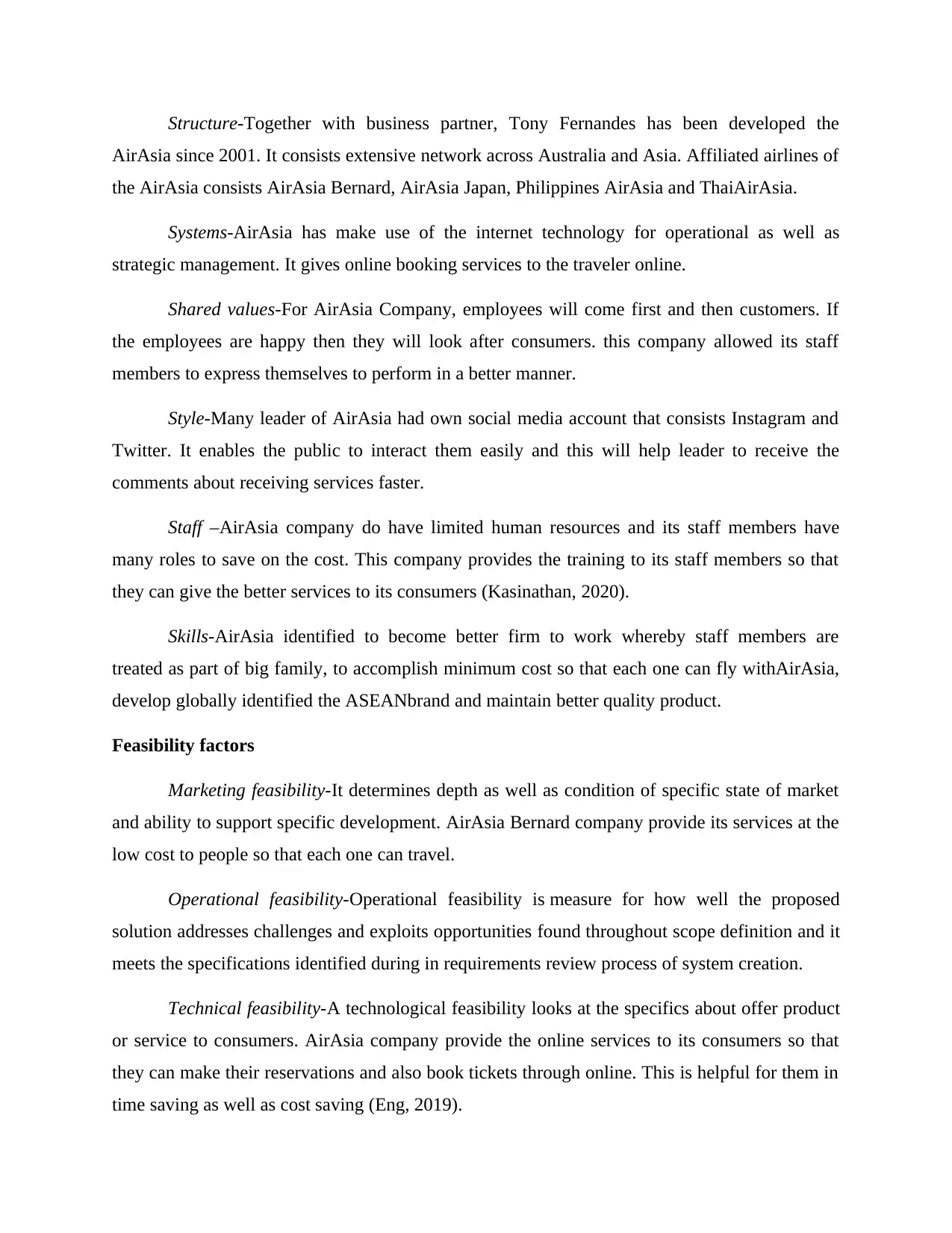
Structure-Together with business partner, Tony Fernandes has been developed the
AirAsia since 2001. It consists extensive network across Australia and Asia. Affiliated airlines of
the AirAsia consists AirAsia Bernard, AirAsia Japan, Philippines AirAsia and ThaiAirAsia.
Systems-AirAsia has make use of the internet technology for operational as well as
strategic management. It gives online booking services to the traveler online.
Shared values-For AirAsia Company, employees will come first and then customers. If
the employees are happy then they will look after consumers. this company allowed its staff
members to express themselves to perform in a better manner.
Style-Many leader of AirAsia had own social media account that consists Instagram and
Twitter. It enables the public to interact them easily and this will help leader to receive the
comments about receiving services faster.
Staff –AirAsia company do have limited human resources and its staff members have
many roles to save on the cost. This company provides the training to its staff members so that
they can give the better services to its consumers (Kasinathan, 2020).
Skills-AirAsia identified to become better firm to work whereby staff members are
treated as part of big family, to accomplish minimum cost so that each one can fly withAirAsia,
develop globally identified the ASEANbrand and maintain better quality product.
Feasibility factors
Marketing feasibility-It determines depth as well as condition of specific state of market
and ability to support specific development. AirAsia Bernard company provide its services at the
low cost to people so that each one can travel.
Operational feasibility-Operational feasibility is measure for how well the proposed
solution addresses challenges and exploits opportunities found throughout scope definition and it
meets the specifications identified during in requirements review process of system creation.
Technical feasibility-A technological feasibility looks at the specifics about offer product
or service to consumers. AirAsia company provide the online services to its consumers so that
they can make their reservations and also book tickets through online. This is helpful for them in
time saving as well as cost saving (Eng, 2019).
AirAsia since 2001. It consists extensive network across Australia and Asia. Affiliated airlines of
the AirAsia consists AirAsia Bernard, AirAsia Japan, Philippines AirAsia and ThaiAirAsia.
Systems-AirAsia has make use of the internet technology for operational as well as
strategic management. It gives online booking services to the traveler online.
Shared values-For AirAsia Company, employees will come first and then customers. If
the employees are happy then they will look after consumers. this company allowed its staff
members to express themselves to perform in a better manner.
Style-Many leader of AirAsia had own social media account that consists Instagram and
Twitter. It enables the public to interact them easily and this will help leader to receive the
comments about receiving services faster.
Staff –AirAsia company do have limited human resources and its staff members have
many roles to save on the cost. This company provides the training to its staff members so that
they can give the better services to its consumers (Kasinathan, 2020).
Skills-AirAsia identified to become better firm to work whereby staff members are
treated as part of big family, to accomplish minimum cost so that each one can fly withAirAsia,
develop globally identified the ASEANbrand and maintain better quality product.
Feasibility factors
Marketing feasibility-It determines depth as well as condition of specific state of market
and ability to support specific development. AirAsia Bernard company provide its services at the
low cost to people so that each one can travel.
Operational feasibility-Operational feasibility is measure for how well the proposed
solution addresses challenges and exploits opportunities found throughout scope definition and it
meets the specifications identified during in requirements review process of system creation.
Technical feasibility-A technological feasibility looks at the specifics about offer product
or service to consumers. AirAsia company provide the online services to its consumers so that
they can make their reservations and also book tickets through online. This is helpful for them in
time saving as well as cost saving (Eng, 2019).
⊘ This is a preview!⊘
Do you want full access?
Subscribe today to unlock all pages.

Trusted by 1+ million students worldwide
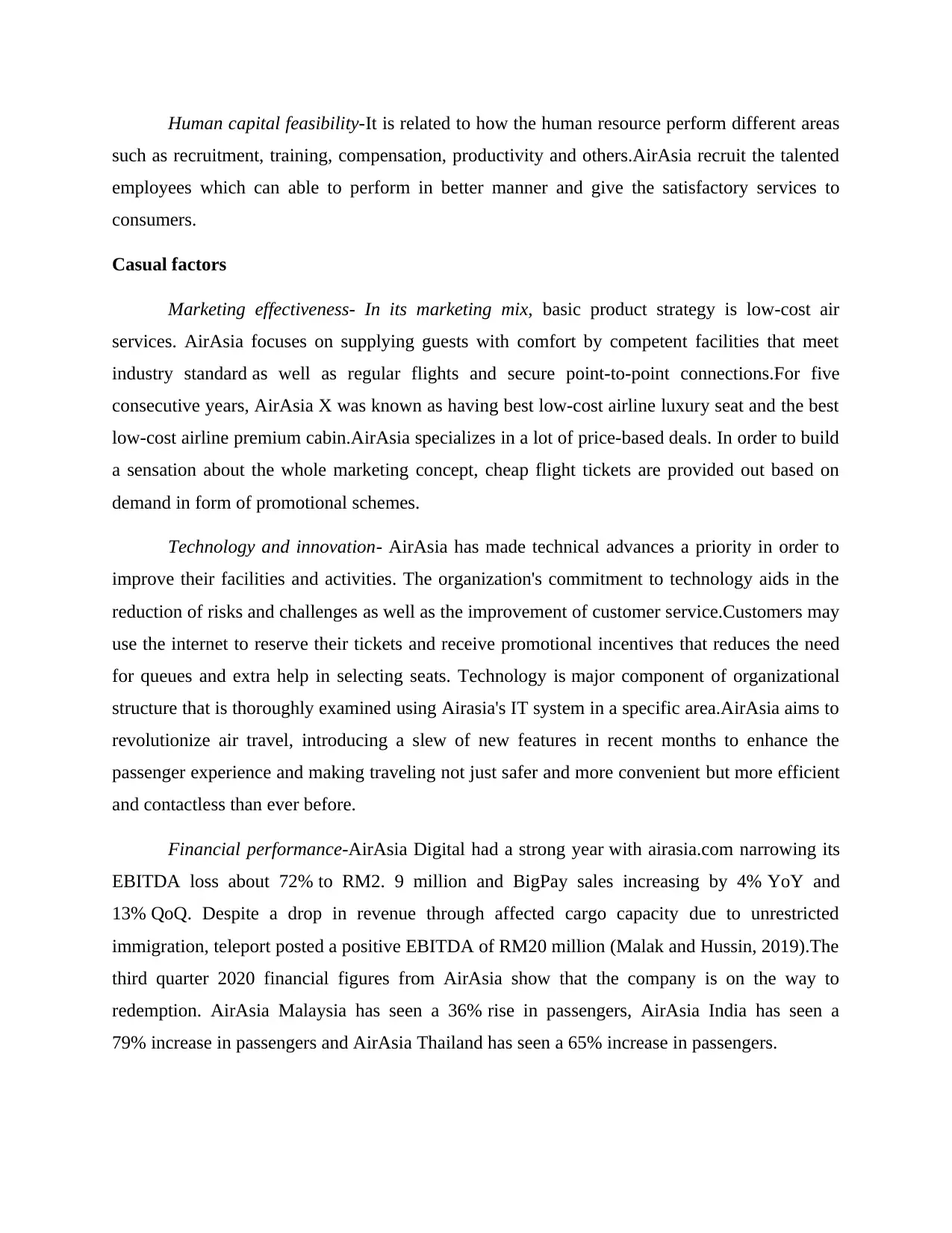
Human capital feasibility-It is related to how the human resource perform different areas
such as recruitment, training, compensation, productivity and others.AirAsia recruit the talented
employees which can able to perform in better manner and give the satisfactory services to
consumers.
Casual factors
Marketing effectiveness- In its marketing mix, basic product strategy is low-cost air
services. AirAsia focuses on supplying guests with comfort by competent facilities that meet
industry standard as well as regular flights and secure point-to-point connections.For five
consecutive years, AirAsia X was known as having best low-cost airline luxury seat and the best
low-cost airline premium cabin.AirAsia specializes in a lot of price-based deals. In order to build
a sensation about the whole marketing concept, cheap flight tickets are provided out based on
demand in form of promotional schemes.
Technology and innovation- AirAsia has made technical advances a priority in order to
improve their facilities and activities. The organization's commitment to technology aids in the
reduction of risks and challenges as well as the improvement of customer service.Customers may
use the internet to reserve their tickets and receive promotional incentives that reduces the need
for queues and extra help in selecting seats. Technology is major component of organizational
structure that is thoroughly examined using Airasia's IT system in a specific area.AirAsia aims to
revolutionize air travel, introducing a slew of new features in recent months to enhance the
passenger experience and making traveling not just safer and more convenient but more efficient
and contactless than ever before.
Financial performance-AirAsia Digital had a strong year with airasia.com narrowing its
EBITDA loss about 72% to RM2. 9 million and BigPay sales increasing by 4% YoY and
13% QoQ. Despite a drop in revenue through affected cargo capacity due to unrestricted
immigration, teleport posted a positive EBITDA of RM20 million (Malak and Hussin, 2019).The
third quarter 2020 financial figures from AirAsia show that the company is on the way to
redemption. AirAsia Malaysia has seen a 36% rise in passengers, AirAsia India has seen a
79% increase in passengers and AirAsia Thailand has seen a 65% increase in passengers.
such as recruitment, training, compensation, productivity and others.AirAsia recruit the talented
employees which can able to perform in better manner and give the satisfactory services to
consumers.
Casual factors
Marketing effectiveness- In its marketing mix, basic product strategy is low-cost air
services. AirAsia focuses on supplying guests with comfort by competent facilities that meet
industry standard as well as regular flights and secure point-to-point connections.For five
consecutive years, AirAsia X was known as having best low-cost airline luxury seat and the best
low-cost airline premium cabin.AirAsia specializes in a lot of price-based deals. In order to build
a sensation about the whole marketing concept, cheap flight tickets are provided out based on
demand in form of promotional schemes.
Technology and innovation- AirAsia has made technical advances a priority in order to
improve their facilities and activities. The organization's commitment to technology aids in the
reduction of risks and challenges as well as the improvement of customer service.Customers may
use the internet to reserve their tickets and receive promotional incentives that reduces the need
for queues and extra help in selecting seats. Technology is major component of organizational
structure that is thoroughly examined using Airasia's IT system in a specific area.AirAsia aims to
revolutionize air travel, introducing a slew of new features in recent months to enhance the
passenger experience and making traveling not just safer and more convenient but more efficient
and contactless than ever before.
Financial performance-AirAsia Digital had a strong year with airasia.com narrowing its
EBITDA loss about 72% to RM2. 9 million and BigPay sales increasing by 4% YoY and
13% QoQ. Despite a drop in revenue through affected cargo capacity due to unrestricted
immigration, teleport posted a positive EBITDA of RM20 million (Malak and Hussin, 2019).The
third quarter 2020 financial figures from AirAsia show that the company is on the way to
redemption. AirAsia Malaysia has seen a 36% rise in passengers, AirAsia India has seen a
79% increase in passengers and AirAsia Thailand has seen a 65% increase in passengers.
Paraphrase This Document
Need a fresh take? Get an instant paraphrase of this document with our AI Paraphraser
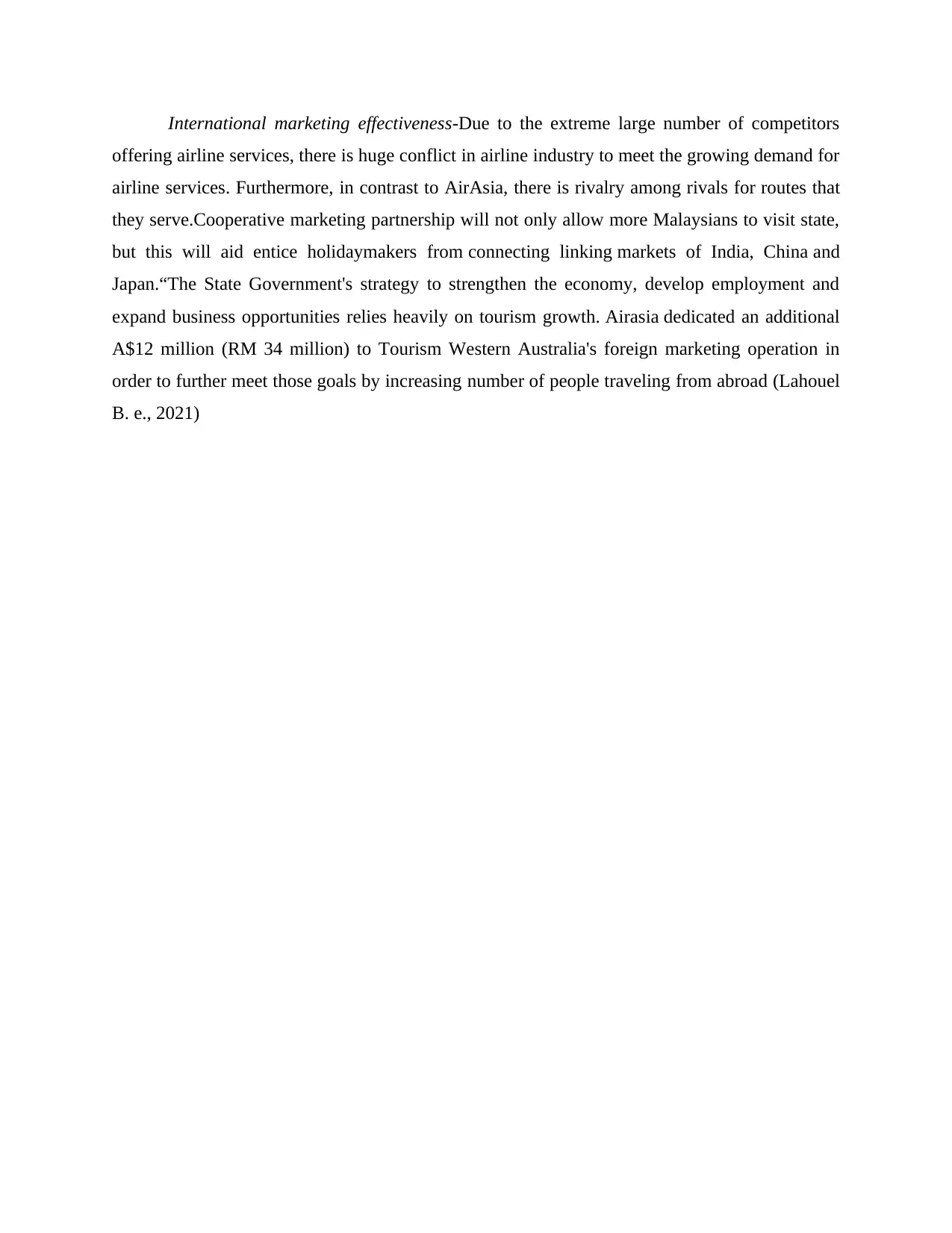
International marketing effectiveness-Due to the extreme large number of competitors
offering airline services, there is huge conflict in airline industry to meet the growing demand for
airline services. Furthermore, in contrast to AirAsia, there is rivalry among rivals for routes that
they serve.Cooperative marketing partnership will not only allow more Malaysians to visit state,
but this will aid entice holidaymakers from connecting linking markets of India, China and
Japan.“The State Government's strategy to strengthen the economy, develop employment and
expand business opportunities relies heavily on tourism growth. Airasia dedicated an additional
A$12 million (RM 34 million) to Tourism Western Australia's foreign marketing operation in
order to further meet those goals by increasing number of people traveling from abroad (Lahouel
B. e., 2021)
offering airline services, there is huge conflict in airline industry to meet the growing demand for
airline services. Furthermore, in contrast to AirAsia, there is rivalry among rivals for routes that
they serve.Cooperative marketing partnership will not only allow more Malaysians to visit state,
but this will aid entice holidaymakers from connecting linking markets of India, China and
Japan.“The State Government's strategy to strengthen the economy, develop employment and
expand business opportunities relies heavily on tourism growth. Airasia dedicated an additional
A$12 million (RM 34 million) to Tourism Western Australia's foreign marketing operation in
order to further meet those goals by increasing number of people traveling from abroad (Lahouel
B. e., 2021)
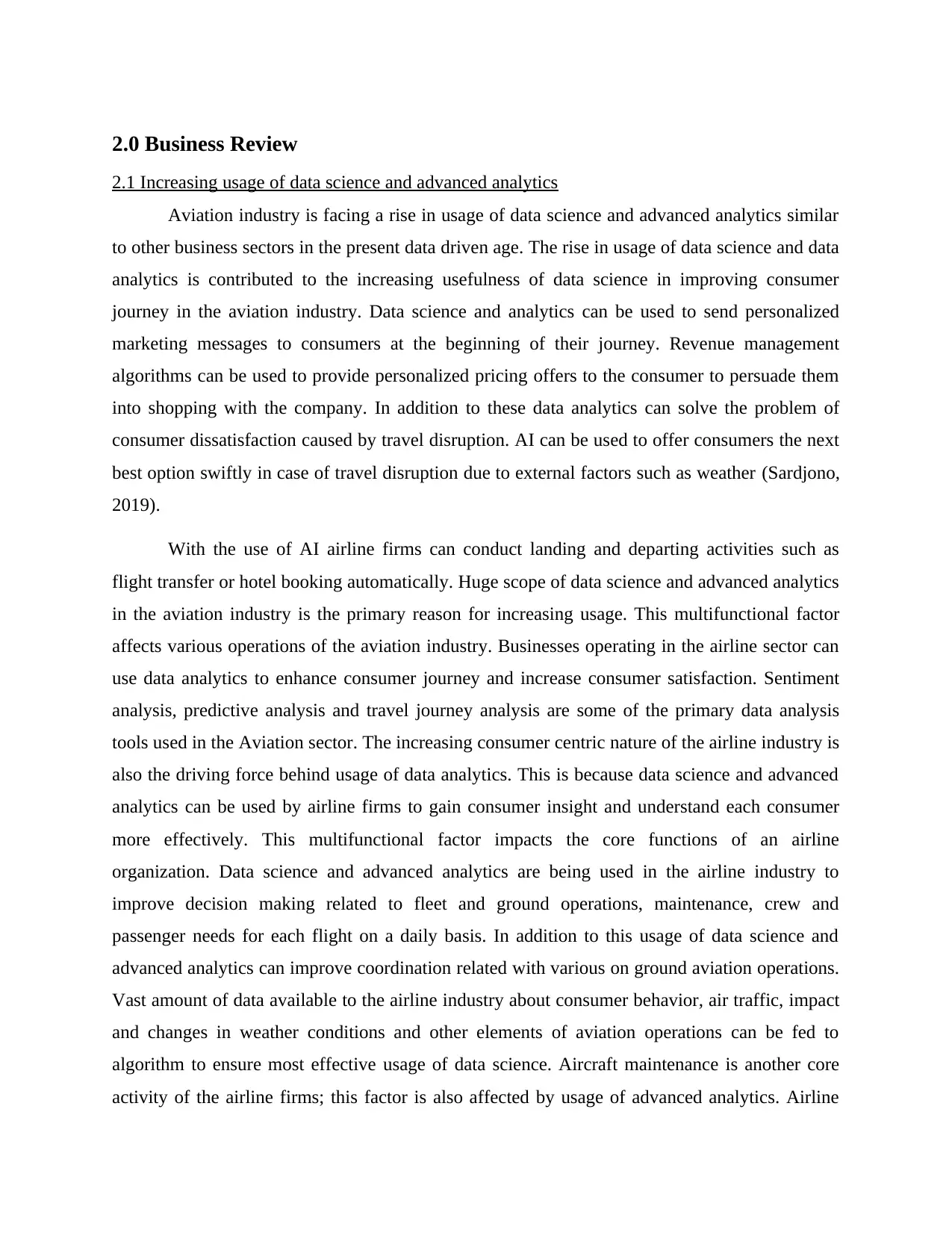
2.0 Business Review
2.1 Increasing usage of data science and advanced analytics
Aviation industry is facing a rise in usage of data science and advanced analytics similar
to other business sectors in the present data driven age. The rise in usage of data science and data
analytics is contributed to the increasing usefulness of data science in improving consumer
journey in the aviation industry. Data science and analytics can be used to send personalized
marketing messages to consumers at the beginning of their journey. Revenue management
algorithms can be used to provide personalized pricing offers to the consumer to persuade them
into shopping with the company. In addition to these data analytics can solve the problem of
consumer dissatisfaction caused by travel disruption. AI can be used to offer consumers the next
best option swiftly in case of travel disruption due to external factors such as weather (Sardjono,
2019).
With the use of AI airline firms can conduct landing and departing activities such as
flight transfer or hotel booking automatically. Huge scope of data science and advanced analytics
in the aviation industry is the primary reason for increasing usage. This multifunctional factor
affects various operations of the aviation industry. Businesses operating in the airline sector can
use data analytics to enhance consumer journey and increase consumer satisfaction. Sentiment
analysis, predictive analysis and travel journey analysis are some of the primary data analysis
tools used in the Aviation sector. The increasing consumer centric nature of the airline industry is
also the driving force behind usage of data analytics. This is because data science and advanced
analytics can be used by airline firms to gain consumer insight and understand each consumer
more effectively. This multifunctional factor impacts the core functions of an airline
organization. Data science and advanced analytics are being used in the airline industry to
improve decision making related to fleet and ground operations, maintenance, crew and
passenger needs for each flight on a daily basis. In addition to this usage of data science and
advanced analytics can improve coordination related with various on ground aviation operations.
Vast amount of data available to the airline industry about consumer behavior, air traffic, impact
and changes in weather conditions and other elements of aviation operations can be fed to
algorithm to ensure most effective usage of data science. Aircraft maintenance is another core
activity of the airline firms; this factor is also affected by usage of advanced analytics. Airline
2.1 Increasing usage of data science and advanced analytics
Aviation industry is facing a rise in usage of data science and advanced analytics similar
to other business sectors in the present data driven age. The rise in usage of data science and data
analytics is contributed to the increasing usefulness of data science in improving consumer
journey in the aviation industry. Data science and analytics can be used to send personalized
marketing messages to consumers at the beginning of their journey. Revenue management
algorithms can be used to provide personalized pricing offers to the consumer to persuade them
into shopping with the company. In addition to these data analytics can solve the problem of
consumer dissatisfaction caused by travel disruption. AI can be used to offer consumers the next
best option swiftly in case of travel disruption due to external factors such as weather (Sardjono,
2019).
With the use of AI airline firms can conduct landing and departing activities such as
flight transfer or hotel booking automatically. Huge scope of data science and advanced analytics
in the aviation industry is the primary reason for increasing usage. This multifunctional factor
affects various operations of the aviation industry. Businesses operating in the airline sector can
use data analytics to enhance consumer journey and increase consumer satisfaction. Sentiment
analysis, predictive analysis and travel journey analysis are some of the primary data analysis
tools used in the Aviation sector. The increasing consumer centric nature of the airline industry is
also the driving force behind usage of data analytics. This is because data science and advanced
analytics can be used by airline firms to gain consumer insight and understand each consumer
more effectively. This multifunctional factor impacts the core functions of an airline
organization. Data science and advanced analytics are being used in the airline industry to
improve decision making related to fleet and ground operations, maintenance, crew and
passenger needs for each flight on a daily basis. In addition to this usage of data science and
advanced analytics can improve coordination related with various on ground aviation operations.
Vast amount of data available to the airline industry about consumer behavior, air traffic, impact
and changes in weather conditions and other elements of aviation operations can be fed to
algorithm to ensure most effective usage of data science. Aircraft maintenance is another core
activity of the airline firms; this factor is also affected by usage of advanced analytics. Airline
⊘ This is a preview!⊘
Do you want full access?
Subscribe today to unlock all pages.

Trusted by 1+ million students worldwide
1 out of 44
Your All-in-One AI-Powered Toolkit for Academic Success.
+13062052269
info@desklib.com
Available 24*7 on WhatsApp / Email
![[object Object]](/_next/static/media/star-bottom.7253800d.svg)
Unlock your academic potential
Copyright © 2020–2025 A2Z Services. All Rights Reserved. Developed and managed by ZUCOL.


